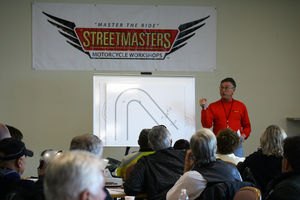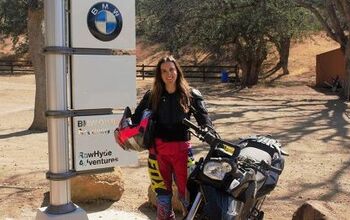Master the Street
Continuing education: It's a familiar concept. If you're within a 20 mile radius of a community college you probably receive more than a few mailers each year announcing a variety of classes offered for the upcoming semester or term. Perhaps you work in a complex environment such as technology, engineering, a science related field, or even law. These fields, and others are dynamic enough that aspects of each will see changes come on a yearly basis. If you want to be successful -- or stay gainfully employed -- continuing training and education are just part of the job.
For the motorcyclist there's no lack of MSF courses, "racing" schools, dirt riding schools, or track-specific multi-day courses to choose from; but how many will take advantage?
Sadly -- despite the availability and opportunities these days -- most motorcyclists don't follow the same principle in their riding careers as they might in their profession or trade. Equally as sad is the fact that I can be slotted right next to the typical motorcyclist.
Essentially a self-taught rider, once I got that M1 endorsement on my California license all of my "training" took place on the mean streets and freeways of Los Angeles. I've only been riding for 13 years, but my time as a motorcycle courier served me well. The sheer volume of miles I put on each year meant that I was sure to learn something. Then along came a spide...um...er...Motorcycle.com, and with it plenty of track time. I don't know it all, but I figured short of racing technique there's little left to learn.
Only the educated are free.--Epictetus, Greek Stoic philosopher
Though there a number of highly qualified instructors besides Bob at Streetmasters, the core group consists of Bob, his wife Jann who handles all your registration needs -- she's the glue that holds the whole show together -- and Walt Fulton. Walt, like Bob, has an equally colorful riding career. A veteran of the race track, he captured three Daytona wins in his time and rode for Harley-Davidson as well as Kawasaki. Even more interesting than his racing success is the history he helped create for the empire of motorcycling: Walt was a featured rider in Bruce Brown's 1971 classic, "On Any Sunday." I'd say that qualifies him to teach me a thing or two.
As for the genesis of Streetmasters, Bob and Walt had very noble desires. Bob had long wanted to create a program aimed at cornering techniques, and Walt had a burning need "to work with beginning riders and women riders because they're so under represented at any track day." They would often lament the lack of such available training with their good friend, the incomparable Fred Rau. One fateful day Walt had a chat with Willow Springs International Motorsports Park owner Bill Huth; the result? Horse Thief Mile was theirs to use. With a venue secured, and a driving passion to help motorcyclists become better riders, Walt ran this good news by Fred. Fred assured Walt that he could rouse plenty of riders from his local Goldwing owners chapter to attend the inaugural session; and so began the life of Streetmasters.
My bike du jour was a healthy sized unit for such an endeavor, but it's more the rule than the exception. Streetmasters is fairly well-known among the Wing crowd so you can expect to find more Wingnuts at any given Streetmasters session than you would at the discount grab-bag table at Ace Hardware. With nearly as strong a showing as the Wingabagos, the Harley contingent had good representation on this day. A smattering of BMWs, Ducati Monsters, Victory cruisers and a couple of current-model Japanese sportbikes made up the rest of the 40 or so riders in attendance. It was a more eclectic crew than I had expected, but the melting pot of bikes warmed my all-things-motorcycle heart. The other thing that fascinated me was the large number of women taking the course. They would have failed to win a majority vote on anything, but I was pleasantly surprised that they made up just under one fourth of the class.
Bob spews gems like,"Slow down and don't commit to a big roll on." and "Don't commit until you can see through the exit of the turn." But if there was one thing that proved to be the single, most useful piece of knowledge that Bob extolled, it was to "turn your head and aim your nose to the exit or where you think the exit will be."
All of the riders I spoke with throughout the day found that consciously aiming their snout as instructed made the biggest improvement to their riding. On the surface Bob's admonitions may seem rudimentary, but if more riders followed them we might see a dramatic drop in the daily news clippings heralding one motorcycle fatality after another.
| If you go... |
| In addition to the Precision Cornering Workshop, Streetmasters has recently added a "two-up" course. From Streetmasters: New Teamwork On 2-Wheels Workshop Created specially for touring, sports-touring, sport bike, cruiser riders -- and their passengers! You'll both learn to be a smoother rider and the perfect passenger by discovering proper body position, leaning techniques, how to avoid helmet "turtle kisses" and much more. Plus you and your friends will master group riding do's and don'ts. When Sunday, June 10, 7:30am to 4:30pm. Rider must be a Streetmasters Precision Cornering Workshop grad -- yes you may take the Precision Cornering Workshop on June 9 and the Teamwork On 2-Wheels Workshop on June 10! Precision Cornering Workshop Our comprehensive Precision Cornering Workshop is designed for touring, sports-touring, sport bike and cruiser riders who want to become smoother, more confident riders -- ready to take on the curves and have fun doing it. It's not about racing or speed, just practical techniques that you can immediately apply in the real world. When April 28 & 29, May 19 & 20, June 9, Sept. 22, Oct. 20 & Nov. 10, 7:30am to 4:30pm. Special dates can be arranged for Riding Clubs & Groups. Additional dates added as needed (see web site.) Where All Streetmasters workshops have a maximum of just 4 riders per instructor for personalized coaching. Held on the Horse Thief Mile at Willow Springs International Motorsports Park near Lancaster, CA, with 11 curves, it rides like a mountain highway with no on-coming traffic -- it's your own personal highway. Cost for Teamwork on Two Wheels Workshop -- $395.00 for the rider & passenger combined. Cost for Precision Cornering Workshop -- $360.00 per rider. Tuition includes all track fees, lunch, refreshments and snacks with 4 riders maximum per instructor for individualized instruction. There is a 15% discount for groups of 4 or more enrolling in the Precision Cornering Workshop only. (Discount may not be combined with any other promotion or discount.) To enroll please call (805) 464-0544. For more information visit http://www.streetmasters.info |
Once classroom time is over the fun begins. After being assigned an instructor each attendee will find themselves in a group of no more than four students. At that point riders are collected into two large gaggles. One group heads to the track for riding sessions while the other is sent to a large skid pad to practice various braking, shifting, accelerating and swerving skills.
Streetmasters does an excellent job of creating a sense of being on an actual roadway by painting yellow stripes down the center of the track. This serves two purposes: it allows you to see just how dangerously close your riding habits may bring you to crossing the yellow and it allows you to use as much of the road as possible to complete the turn. "Use as much of the road as needed, so long as you can see the whole road.", says Bob. At a minimum, not having real tractor-trailers, stray dogs, miscellaneous debris and anything else you've seen strewn in the roadway makes for a safe environment to discover where you may be mucking things up.
The Master Speak : Timeless Advice From StreetmastersBob Reichenberg:
"Slow down. Don't commit to a big roll-on."
"Never go into a corner so fast that you can't change your line."
"As you go through a turn, be sure to keep picking new visual targets (reference points)."
"Stay as wide as you can as late and as safely as you can."
"Be in the correct lane position at the right speed and in the right gear."
"Stay on top of your perishable skills. If you don't have them ready, you're wasting your time."
Walt Fulton:
"I would recommend to someone that just wants to go out for a ride...don't. Whenever you want to go out for a ride, go out and work on something. Be obsessive in what you do and always strive to get better and improve. Don't go out [and ride] without a purpose."
Of the many Bobisims that Bob Reichenberg is known for, one in particular stood out: "The two seconds between 'Oh shit!' and the crash isn't a lot of practice time." Bob echoed Walt's sentiment about being obsessive in learning when he said, "When you need it most there isn't any time left to practice."
At the end of each group's last track session instructors had a little fun of their own -- in the spirit of teaching, of course. Students were instructed to run the course one final time, backwards. The course became an unfamiliar environment; just what the instructors hoped for. This surprise tactic clearly illustrated that the road is the variable, but the skills and techniques learned are reliable constants.
My time spent at Streetmasters was well worth it. Time spent honing skills I was sure I had down pat; simple skills that students with over 30 years of riding under their belt struggled to sharpen after hours of practice.
I asked Bob, Jann and Walt why they didn't create something on the order of riding schools by Keith Code or Reg and Jason Pridmore. Walt replied, "Those and others are great for a track setting, but how much of your life do you spend on a track?" With a united mindset they stated with confidence that, "No one else is providing a program like Streetmasters." Indeed, it is a unique offering among rider education and one worthy of any rider's time and money.
More by Pete Brissette




































Comments
Join the conversation